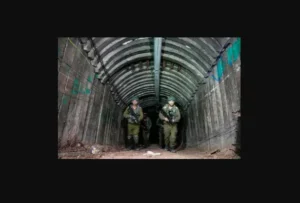Punjab Govt Plans Artificial Rain on Nov 28 to Fight Smog in Lahore.
Amid growing concerns over deteriorating air quality in Lahore, the Punjab government is set to implement an innovative strategy to combat the rising smog.
Scheduled for November 28, artificial rain will be induced in the city as part of a proactive approach to tackle the escalating environmental crisis.
Read More: What is Raiwind Ijtema?
The decision was made during a special meeting chaired by the Punjab caretaker chief minister, reflecting the government’s commitment to finding effective solutions to address the smog-related challenges faced by the provincial capital.
In light of the worsening smog conditions, the Punjab government declared a health emergency on Wednesday, prompting the closure of educational institutions, markets, and offices in eight districts of Punjab on Saturday.
Caretaker Chief Minister Mohsin Naqvi, leading the charge against the smog menace, announced the implementation of Section 144 in Lahore, Gujranwala, and Hafizabad.
Under the Section 144 orders, a range of establishments, including educational institutions (both public and private), offices, cinemas, parks, and restaurants, will observe a temporary closure on Saturday.
Read More: Al Kabir Orchard Overseas Prime
Markets, too, will experience a shutdown on the specified day, emphasizing the gravity of the situation and the need for collective action to address the environmental challenges posed by smog.
In response to escalating smog concerns in Lahore, the Punjab government is set to implement a groundbreaking solution – artificial rain using chemical dispersal.
The decision, made during a cabinet meeting chaired by caretaker Chief Minister Mohsin Naqvi, aims to mitigate the hazardous effects of smog in the provincial capital.
This innovative approach, scheduled for November 28 or 29, involves the dispersal of chemicals into clouds to stimulate precipitation, commonly known as cloud seeding.
The move follows recent rainfall that provided temporary relief from smog on November 11.
Read More: Karachi Express: Discover Karachi to Lahore Routes
To facilitate the artificial rain initiative, a working group will be formed to oversee the process. However, experts emphasize the conditional nature of its success, requiring at least 40% cloud cover, humidity levels of at least 70%, and wind speeds between 30 to 50 km per hour.
Despite potential short-term benefits, experts caution that artificial rain is not a permanent solution to pollution. While it may temporarily reduce pollution levels, there is no guarantee of sustained clean air, as pollution can resurface after the artificial rain process.
As the government proactively addresses the smog crisis, the induction of artificial rain on November 28 stands out as a forward-thinking measure to alleviate the impact on Lahore’s residents.
This innovative approach signals a commitment to exploring unconventional yet effective solutions in the ongoing battle for cleaner air and a healthier environment.
Read More: Shenzhen City Lahore Payment Plan
In response to escalating concerns over deteriorating air quality in Lahore, the Punjab government is gearing up to implement an unconventional yet innovative strategy to combat the rising smog crisis.
The key element of this approach is the induction of artificial rain, achieved through the dispersal of chemicals, with plans set for November 28.
This strategic decision comes in the wake of a health emergency declared by the Punjab government on Wednesday, prompting the temporary closure of educational institutions, markets, offices, and other public spaces in eight districts, including Lahore, on Saturday.
Caretaker Chief Minister Mohsin Naqvi has also enforced Section 144 in Lahore, Gujranwala, and Hafizabad, further underlining the severity of the situation.
The artificial rain initiative, discussed in a cabinet meeting chaired by Mohsin Naqvi, involves cloud seeding, a weather modification technique aiming to enhance precipitation by dispersing substances into the air.
The proposed method, while innovative, is contingent on specific conditions, such as a minimum cloud cover of 40%, humidity levels exceeding 70%, and wind speeds ranging from 30 to 50 km per hour.
Read More: Islamabad to get 78 Feeder Electric Metro Buses
Though artificial rain may offer temporary relief, experts caution that it is not a panacea for pollution. Punjab Govt Plans Artificial Rain on Nov 28 to Fight Smog in Lahore is considered as a right approach.
While it may temporarily reduce pollution levels, the longevity of clean air remains uncertain, as pollution may resurge after the artificial rain process.
As the government takes proactive measures to address the smog crisis, the decision to induce artificial rain on November 28 reflects a commitment to exploring unconventional yet effective solutions in the ongoing battle for cleaner air and a healthier environment.
How Much Will it Cost for Artificial Rain in Lahore to Curb Smog?
The Punjab government is contemplating the utilization of artificial rain, also known as cloud seeding, in Lahore to combat the severe smog affecting citizens’ health. Caretaker Punjab Chief Minister Mohsin Naqvi revealed plans for cloud seeding on November 29 and 30, pending suitable weather conditions.
Cloud seeding, a weather modification technique, involves introducing substances into clouds via aircraft to stimulate precipitation. The provincial Information Minister, Amir Mir, mentioned the involvement of Chinese experts in the process, estimating a cost of approximately Rs350 million for the initiative in Lahore’s smog-affected areas.
In response to the smog crisis, the Punjab government has issued a notification closing all educational institutions on Friday and Saturday. The affected divisions, including Lahore, Gujranwala, Multan, Sargodha, Faisalabad, and Sahiwal, are declared calamity-affected areas with restricted movement as part of safety measures for smog prevention and control. The government is taking decisive steps, including innovative approaches like artificial rain, to address the pressing issue of smog in the region.
Note: The information above might not be accepted 100%. Please verify from your own sources. We will not be responsible for any kind of loss due to our content.
For more news, please visit Munafa Marketing.




